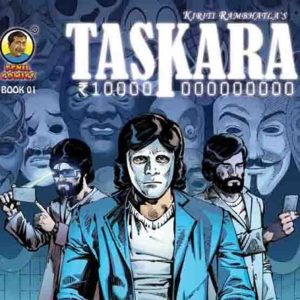A keynote on Indian comics and their business model analysis at GAFX Bengaluru 2019.
Kiriti Rambhatla Views on India comics

August 07th, 2019
Rambhatla is also a writer, graphic novelist and an actor whose work has appeared across television, novels and live-action feature films. Excerpts:
What are your thoughts on the current comic-book scene in India?
The current comic book scene in India is upbeat from a demand perspective. However, the supply of domestic content needs to focus on three things: local stories, local languages and distribution. Most of the Indian comic book scene in English reaches out to a tiny segment of the readers in metro cities. There needs to be a push on the distribution side to reach tier two and three cities as well.
You drew interesting parallels between popular western superheroes and Indian mythological characters. Would you say that Indian mythological characters packaged as superheroes would make for equally successful IPS and find resonance?
If Chota Bheem is anything to go by in the kids’ segment – we have millions of characters from our own mythology that has found major success in television (Mahabharat of the 1980s) and big screen numerous blockbusters from South Indian film industries on Ramayan and Mahabharat). Even Bahaubali has its roots deeply ingrained in our mythology. So yes, if packaged really well – we can make world-class superhero content. However, we have a very poor IP structure which is turning out to be a hindrance.
There seems to be a considerable rush amongst Indian comic-book artists and animation sector of modelling their IP’s around a variety of Indian mythological characters. What are your thoughts on that?
We should encourage more of homegrown IP and promote it among venture capital/production studious to garner more awareness. It is good to have a wide variety of animation and comic book adaptations on these characters. The more awareness in the market, the better it is for the growth of the segment.
Despite a long and pedigreed history of comic books, India’s comic book scene seems to be dwindling over the years. Could you discuss as to why India’s comic book scene is not taking flight?
We cannot bring all of Indian comics under one roof. Think of the same parallel between movies. Can you say Indian movies are just Hindi movies? South Indian movies from Telugu and Tamil industries make more movies and have collections and global reach at par with Hindi films. So when one says Indian films, we need to take all the languages into consideration. Similarly comics – we need to bring a structured approach to monitoring comics in all languages to understand the flaws and address them. Currently, work is centred in micro pockets which doesn’t analyze the macro picture well. That is the reason why Comic book publishers are unable to see the big picture. They need to take a leaf out of production houses which are making movies and dubbing them into regional languages to explore new markets.
How do you think could we go about promoting the comic-book scene? What sort of business model do we need to put in place to make it a viable and profitable occupation?
Many things across the value chain. We need to understand comic book production value chain and ensure we create content which is of international standards. Right from artwork to distribution. Think about how Marvel movies made in English are being dubbed into Hindi, Telugu and Tamil and making way to local theatres. Can comics also look at the same model and find their way to readers locally and internationally? We need a model that provides incentives to readers to engage with content. Unfortunately, due to dwindling print sales, publishers are struggling with exploring new models. Digital is a medium which is not explored to its full potential. Publishers need to focus on it for a sustainable business model. How do you think Digital Media is affecting the Comicbook scene in India?
It has barely scratched the surface. Especially legacy comic book publishers have not been able to catch on to the bandwagon of digital. It has the potential to disrupt the industry in a big way – the publishers need to come together to address it collectively.
How was your experience at GAFX 2019?
I was amazed at the scale of GAFX and when I heard the story from the founders on the journey – I was inspired. GAFX is the perfect launchpad for Comics segment in India to take off through their Centre of Excellence. More power to them.
What inspired you to write comic books?
I was essentially exposed to a lot of comics as a child from vernacular Indian languages to mainstream American comics. As I grew, I was fascinated with building things. As I was hosting the talk show on television where I was scripting content for episodes – the idea behind making my own characters came. That’s how my first character was born which was then adapted to a live-action feature film screenplay too. Could you summarise the presentation you gave at GAFX?
The talk focuses on the history of Indian comics split into generations and what we can learn from the golden period of Indian comics like Chandamama and Amar Chitra Katha. Every business goes through a boom and bust cycle. What can we do now to ride the wave back to a boom in the sector is the crux of the talk.
Relates News
FICCI Frames partners with Australia
At FICCI Frames 2014, Australia is the partner country and Karnataka the “Partner Stateâ€
February 26th, 2014 Read more
SIGGRAPH 2019 Announces Exclusive Making Of VFX Production Sessions
Productions Sessions are open to conference participants with Select Conference, Full Conference, or Full Conference Platinum registrations.
June 18th, 2019 Read more












